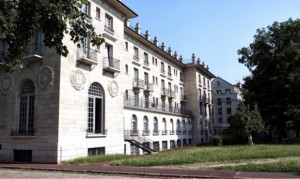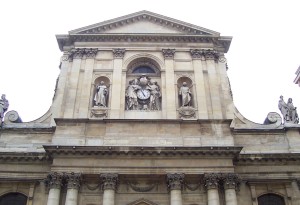HISTORY OF THE PARISIAN “CASA CUBA” FOR STUDENTS IN FRANCE.
In 1919, just ended the First World War, the idea of creating a university town in Paris which accommodated students from around the world was getting around in the intellectual circles in France.

It was then that Pierre Sanchez Abreu (1890-1952), a wealthy lawyer based in France, a descendant of an illustrious family of colonial Cuba, decided to build a house for Cuban students in the City of Light. For this he had the support of his sister Rosalie, better known as Lilith (1886-1955). Both wanted to create a foundation in honor of his aunt, Rosa Abreu Arencibia, widow of Professor Jacques-Joseph Grancher. The latter had been a great friend and collaborator of Louis Pasteur, in particular during the French scientific studies devoted to the rabies vaccine.
The Sanchez Abreu brothers wanted to perpetuate the philanthropic tradition of Rosa Abreu, who largely helped Cuban students passing through Paris and had also financed his hometown of Santa Clara multiple charities and charity from the 1870s.
The February 25, 1929 Pierre Sanchez Abreu and her sister signed the deed of gift, which was approved by decree on 26 May. The document preserved in the archives of the Cité Universitaire, donors gave a plot of 1,824 sqm, and they pledged to “build and furnish the enclosure of the University City, a property that allows Cuban students benefit and the advantages of said City … destined to become after its construction, property of the University of Paris. ” These archives contain extensive documentation that reflects in many ways the history of Cuba or international events such as the occupation of Paris during World War II.
The regulation stipulated the foundation as an official name “Université de Paris Fondation Rosa Abreu de Grancher in faveur des étudiants cubains” (University of Paris Foundation Grancher Rosa Abreu, for the benefit of Cuban students).
Donors decided to commission the construction of the House of Cuba to the French architect Albert Laprade (1883-1978), who began to be distinguished as one of the most famous exponents of the art deco style. On April 3, 1930 the rector of the University of Paris received permission to build the residence by the local authorities. Just two years later the institution fully assumed its duties, although the official inauguration took place on January 14, 1933.
A mid-century house in Paris Cuba welcomed much of the Cuban cultural elite. Other residents include artists Angel Acosta Leon, Ramon Alejandro Agustin Cardenas, Joaquín Ferrer, Roberto Garcia-York, Gina Pellon and Lolo Soldevilla, filmmaker Nestor Almendros, or intellectuals Rine Leal and Severo Sarduy.
Since opening, the House of Cuba was considered one of the most luxurious, and especially of comfort. The general reinforced concrete structure used as building technique, but the facades are covered with hard stone of Saint-Maximin, Saint-Wast Vergelé and rock Comblanchien. These materials evoke the characteristic stone masonry of the Cuban stately architecture of the colonial period.
On the main facade, inspired by the Cathedral of Havana, stands the monumental entrance framed by elegant columns. Its top center shows the shield of the Republic of Cuba in relief on a semicircular cornice and arranged symmetrically, two stand forehearths with carved stone medallions representing Euville weapons of six former provinces.
The furniture in the living room, which is now kept in their great majority, was imported from Havana. Some of the tables and chairs preserve the metal plate that identifies the manufacturer: “Neptune 186 Tél.A.4288 Cayon House Havana-Cuba…”
One aspect highlighted by the majority of newspaper articles and other archival home is the possession in each of the seventy rooms, individual bathrooms with hot and cold water 24 hours along with phones and clock electric. The residence had since its opening lift and many amenities including kitchen, laundry and breakfast and snack. No detail was neglected. Inventories evoke the existence of hangers identified with the name of the foundation, covered with silver adorned with the coat of the Republic of Cuba made by the Parisian silversmith Christofle house, fine glassware and china from Limoges, while not described in the documentation, it was also adorned with cuban shield as testimonial sources. Currently none of these accessories is preserved.
A study of the documentary resources of the Foundation Abreu Grancher shows the progressive deterioration of the building throughout the twentieth century, despite some partial restorations, and the gradual disappearance of much of their asset. The House of Cuba was vandalized during the dramatic occupation of Paris between 1940 and 1944. The building was one of the first occupied by the German military and then by US troops during the first months of release.
Pierre Sanchez Abreu died in Havana on February 21, 1952 and his son Jean-Claude Abreu (1922-2006) took his place on the Board of Directors of the Cuban Foundation in 1955. Since 1959, Cuban ambassadors Harold Gramatges and Alejo Carpentier tried unsuccessfully to amend the statutes of the institution in order to fully control its direction. However, in August 1975 the University of Paris, after years of litigation, decided to assimilate the House of Cuba and definitely win his tutelage. Today only the name and what is left of its original heritage honor their generous founders and our national culture.
Wikipedia / Internet Photos / Excerpts/ TheCubanHistory.com
The Cuban History, Hollywood.
Arnoldo Varona, Editor.
HISTORIA DE LA PARISINA “CASA CUBA” PARA ESTUDIANTES EN FRANCIA.
En 1919, recién finalizada la Primera Guerra Mundial, surgió la idea de crear en París una ciudad universitaria que acogiera a estudiantes del mundo entero.
Fue entonces cuando Pierre Sánchez Abreu (1890-1952), un acaudalado abogado asentado en Francia, descendiente de una ilustre familia de la Cuba colonial, decidió construir una casa para los estudiantes cubanos en la Ciudad Luz. Para ello contó con el apoyo de su hermana Rosalía, más conocida como Lilita (1886-1955). Ambos deseaban crear una fundación en homenaje a su tía, Rosa Abreu Arencibia, viuda del profesor Jacques-Joseph Grancher. Este último había sido un gran amigo y colaborador de Louis Pasteur, en particular durante los estudios que el científico francés dedicó a la vacuna antirrábica.
Los hermanos Sánchez Abreu quisieron perpetuar la tradición filantrópica de Rosa Abreu, quien ayudaba ampliamente a los estudiantes cubanos de paso por París y había financiado también en su ciudad natal de Santa Clara múltiples obras caritativas y de beneficencia desde los años de 1870.
El 25 de febrero de 1929 Pierre Sánchez Abreu y su hermana firmaron el acta de donación, que fue aprobada por decreto el 26 de mayo. El documento, conservado en los archivos de la Cité Universitaire, otorgaba a los donantes un terreno de 1.824 m², y los mismos se comprometían a “edificar y amueblar en el recinto de la Ciudad Universitaria, un inmueble que permita a los estudiantes cubanos el beneficio y las ventajas de dicha Ciudad… destinado a convertirse tras su construcción, en propiedad de la Universidad de París”. Esos archivos conservan una abundante documentación que refleja en múltiples aspectos la historia de Cuba o acontecimientos internacionales como la ocupación de París durante la Segunda Guerra Mundial.
El reglamento de la fundación estipulaba como nombre oficial “Université de Paris Fondation Rosa Abreu de Grancher, en faveur des étudiants cubains” (Universidad de París Fundación Rosa Abreu de Grancher, a beneficio de los estudiantes cubanos).
Los donadores decidieron encargar la construcción de la Casa de Cuba al arquitecto francés Albert Laprade (1883-1978), quien comenzaba a distinguirse como uno de los más célebres exponentes del estilo art decó. El 3 de abril de 1930 el rector de la Universidad de París recibió la autorización de construir la residencia por parte de las autoridades locales. Apenas dos años después la institución asumía plenamente sus funciones, aunque la inauguración oficial tuvo lugar el 14 de enero de 1933.
A mediados del pasado siglo la Casa de Cuba en París acogió a gran parte de la elite cultural cubana. Entre otros residentes destacan los artistas Ángel Acosta León, Ramón Alejandro, Agustín Cárdenas, Joaquín Ferrer, Roberto García-York, Gina Pellón y Loló Soldevilla, el cineasta Néstor Almendros, o los intelectuales Rine Leal y Severo Sarduy.
Desde su apertura, la Casa de Cuba fue considerada como una de las más lujosas, y sobre todo la de mayor confort. La estructura general emplea el hormigón armado como técnica constructiva, pero las fachadas están recubiertas de piedra dura de Saint-Maximin, Vergelé de Saint-Wast y roca de Comblanchien. Estos materiales evocan la piedra de cantería característica de la arquitectura señorial cubana del periodo colonial.
En la fachada principal, inspirada en la de la Catedral de La Habana, destaca la entrada monumental enmarcada por elegantes columnas. Su parte superior central ostenta el escudo de la República de Cuba en relieve sobre una cornisa semicircular y, dispuestos de forma simétrica, sobresalen dos antecuerpos con medallones esculpidos en piedra de Euville representando las armas de las seis antiguas provincias.
El mobiliario del salón, que actualmente se conserva en su gran mayoría, fue importado de La Habana. Algunas de las mesas y butacas preservan la placa metálica que identifica al fabricante: “Casa Cayón. Neptuno 186 Tél.A.4288. Habana-Cuba”.
Un aspecto de la casa destacado por la mayor parte de artículos de prensa y otros documentos de archivo es el hecho de poseer en cada una de las setenta habitaciones, cuartos de baño individuales con agua fría y caliente las 24 horas, además de teléfono y reloj eléctrico. La residencia contó desde su apertura con ascensor y múltiples comodidades como cocina, servicio de lavandería y de desayuno y merienda. Ningún detalle fue descuidado. Los inventarios evocan la existencia de perchas identificadas con el nombre de la fundación, cubiertos de plata ornados con el escudo de la República de Cuba realizados por la casa de orfebrería parisina Christofle, cristalería fina y una vajilla de porcelana de Limoges, que si bien no se describe en la documentación, estaba igualmente ornada con el escudo cubano, según fuentes testimoniales. Actualmente no se conserva ninguno de estos accesorios.
Un estudio de los fondos documentales de la Fundación Abreu Grancher muestra el progresivo deterioro del edificio a lo largo del siglo XX, a pesar de algunas restauraciones parciales, y la paulatina desaparición de gran parte de su patrimonio mobiliario. La Casa de Cuba fue objeto de vandalismo durante la dramática ocupación de París entre 1940 y 1944. El edificio fue uno de los primeros ocupados por los militares alemanes y seguidamente por las tropas norteamericanas durante los primeros meses de la liberación.
Pierre Sánchez Abreu falleció en La Habana el 21 de febrero de 1952 y su hijo Jean-Claude Abreu (1922-2006) ocupó su lugar en el Consejo de Administración de la Fundación Cubana en 1955. A partir de 1959, los embajadores cubanos Harold Gramatges y Alejo Carpentier trataron infructuosamente de modificar los estatutos de la institución con el objetivo de controlar completamente su dirección. Sin embargo, en agosto de 1975 la Universidad de París, después de años de litigio, decidió asimilar la Casa de Cuba y adjudicarse definitivamente su tutela. Hoy en día solo el nombre y lo que queda de su patrimonio original hacen honor a sus generosos fundadores y a nuestra cultura nacional.
WikiPedia/Internet Photos/Extractos/TheCubanHistory.com
The Cuban History, Hollywood.
Arnoldo Varona, Editor.






